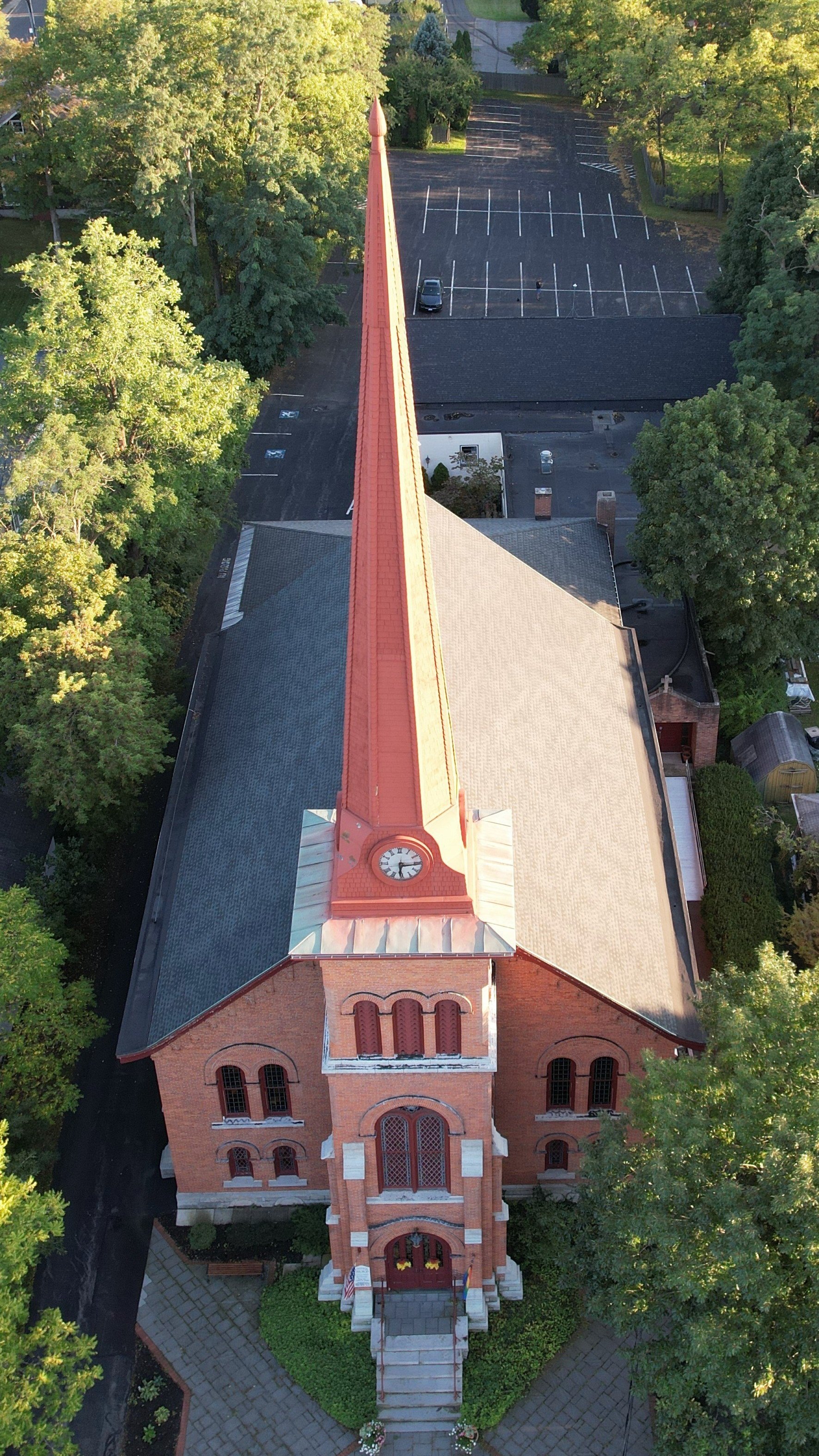UCF History & Building
The Church in the Heart of the Village
Long recognized by its towering spire and village clock, the United Church of Fayetteville (UCF) has an equally towering history of committed ecumenical activity, work for justice and service to those in need. These values come to us from our historic roots, which have two main branches: our ancestor congregations in the Presbyterian Church USA and American Baptist USA traditions.
Our Story Begins Here
The Baptist Branch
In 1792, Gershom Breed, a Revolutionary War veteran, began leading prayer and meditation gatherings in settlers’ homes in a wilderness area that would eventually become the Village of Fayetteville. By 1798, the worshipers had crafted a covenant for their life together. They organized formally as a Baptist congregation in 1804. They met in a schoolhouse until 1830, when they built their first building. This was replaced by a larger building in 1872, located across East Genessee Street from the current site of UCF.
The Presbyterian Branch
In that same era, Presbyterians were meeting in the home of David Collin. In 1829, they built their first church in the Village, complete with a clock tower and steeple, on the current site of UCF. Twenty years later, they began to gradually expand the building, first adding Beard Lounge and an upstairs office. These historic spaces are present in the existing building. President Grover Cleveland’s father, Rev. Richard Cleveland, served as pastor from about 1840 until 1850.
The Branches Intertwine
The two congregations remained collegial but separate until the coal shortage of World War I led them to conduct joint services, alternating the use of their respective buildings. In 1933, the congregations decided to make the arrangement permanent and adopted the Presbyterian facility as the united congregation’s home. The Baptist Church was sold and later razed. Over the years, UCF’s building has been expanded to add a kitchen, a second lounge and a fellowship hall. The sanctuary was renovated and the basement added following the collapse of the sanctuary floor during the Easter Service in 1957.
Our Story Continues
The United Church of Fayetteville continues a longstanding tradition of engaging in the issues of the day, guided by prayerful reflection, moved by God’s love, and inspired by God’s grace. UCF’s antecedent congregations, over a century ago, were active in the abolition of slavery and suffrage for women over a century ago. More recently, UCF has engaged in ministry and education on issues such as the death penalty, poverty and hunger, refugee resettlement, LGBTQIA+ equality, and equal access for differently-abled persons. In the spirit of its own blended ecumenical history, the UCF congregation remains committed to collegial relationships, respect, and shared service with people of all faiths, within and beyond the Christian tradition. We believe that we are servants of a greater community, called to be spiritually hospitable to one another and to offer concrete acts of welcome and care.
UCF’s Johnson Organ
UCF’s pipe organ was built in 1871 by William A. Johnson of Westfield, MA, and his son, William H. Johnson. The original pipes used a mechanical linkage, or ‘tracker action’, to open the valves, allowing air to flow in the pipes and create sound. After the collapse of the sanctuary floor in 1957, the organ was installed in its current location in the rear balcony and rebuilt by Chester A. Raymond of Princeton, N.J., in 1959. At this time, the pipes were upgraded to a pneumatic mechanism, which uses compressed air to control the valves.
The organ has undergone several renovations since 1959, including a console replacement in 1989. The current console consists of three keyboard manuals and 27 ranks of pipes plus, three 16’ extensions and chimes. The Great division was repositioned by Kerner and Merchant Pipe Organ Builders, Ltd., in 1994, and was renovated in 2004. UCF’s organ is mentioned in the book, The Johnson Organs: The Story of One of Our Famous American Organ Builders, by John Van Varick Elsworth and edited by Donald R. M. Paterson.
Our Stained Glass Windows
For centuries, churches have used stained glass windows to teach worshipers about important Bible stories and concepts. The United Church of Fayetteville’s sanctuary windows follow this tradition by using historic symbols with Christian significance.









